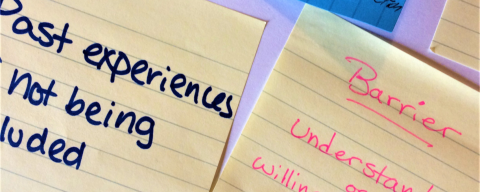UNH Cooperative Extension hosted session II of the 2018 Community Engagement Academy in Dover. I was invited to attend as the Community & Economic Development Intern with Extension. The goal of the session was to address ways to engage underrepresented populations. Individuals from community development committees, main street organizations, and other nonprofits from across the state participated. I had no doubt the academy would be a great opportunity to network and learn about engagement strategies.
We began the morning by defining a handful of necessary terms for effective and thorough engagement: diversity, inclusion, and equity. This led us into a discussion of how to promote diversity and inclusion in community work. Various participants and Extension staff shared successful techniques like forming storytelling groups, putting on community dinners, and doing design charrettes in public spaces. We heard about engagement events in Nashua and Portland, ME. It was becoming clear to everyone that full engagement work was challenging yet certainly attainable and affordable.
The morning concluded with a brief introduction on Story Maps. This is something I had been lightly exposed to before, but quickly realized the engagement potential of the innovative piece of technology. We talked about the need for flexible and accessible citizen involvement and Story Maps had the capability of doing just that. Although the software is primarily used for asset mapping, some commented on the ways it could be used to gather data on opportunities, too. We all decided that photos were invaluable and that this was an amazing opportunity to encourage broader participation in our communities.
I was able to chat with a number of interesting individuals at lunch. I talked with Pedro Altagracia about engaging New Hampshire residents on legislative activity in Concord and I learned about the latest workforce housing projects from Sarah Gartska. I had never been around so many motivated and generous people committed to improving their communities through public participation.
After lunch, we learned about the Dover Art Walk and enjoyed a brief walking tour. We visited art studios, a flower shop, and the Children’s Museum. I was definitely surprised to learn about the well-establish artist and gallery network in Dover. This was evidently something very few of us knew about.
Storytelling was the final activity of the day. We split up into small groups and shared personal memories of when we felt especially welcomed. My group found that many of our reflections included a feeling of inclusion due to sharing food and the unexpected feeling of community when meeting new people. These were powerful concepts to keep in mind as we aspired to be more welcoming to new and underrepresented community members in our daily lives. Aside from our realizations, the process of storytelling was presented as a method in itself for community engagement.
We wrapped up at 7th Settlement Brewery. We learned about the ways the brewery had prioritized community inclusion as we sat at long community tables and toured the brewing facility. The owner of 7th Settlement illustrated the important role businesses should play in engagement and outreach. I sat with a diverse group of volunteers and professionals and discussed my plans for the next step of my career, as I will graduate in a couple of weeks. I successfully added to my list of professional networking contacts and acknowledged the new perspectives I had absorbed on community engagement.

